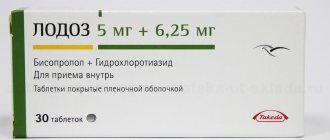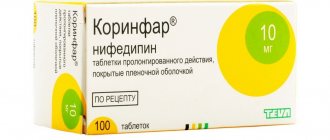Author of the article
Evgeniy Nikolaevich Konoplev
Reading time: 3 minutes
AA
With age, the load on the heart increases; due to frequent stress, interruptions in blood circulation occur, veins and arteries narrow. In such cases, doctors recommend the use of drugs that purify the blood and remove platelet deposits on the walls of blood vessels. Such drugs include Prazosin. It blocks alpha adrenergic receptors and dilates blood vessels.
Prazosin
The drug Prazosin is a peripheral vasodilator.
It is a blocker of postsynaptic α1-adrenergic receptors and prevents the vasoconstrictor effect of catecholamines. Lowers blood pressure by reducing peripheral vascular resistance and reduces afterload on the heart. Dilates peripheral veins, also reducing preload on the heart. Improves systemic and intracardiac hemodynamics in patients with chronic heart failure. Reduces pressure in the pulmonary circulation. The vasodilating effect of prazosin is accompanied by moderately severe reflex tachycardia. With long-term administration, it reduces the concentration of atherogenic lipids in the blood. Reduces myocardial oxygen demand and increases stroke volume during physical activity. Reduces renal vascular resistance. Reduces resistance and pressure in the urethra (by relaxing the smooth muscles of the bladder neck, prostate gland and its capsule), which leads to a weakening of the severity of symptoms of urinary tract dysfunction. The maximum hypotensive effect after taking a single dose develops after 1-4 hours, the duration of action is up to 10 hours. Both early (3-5 days) and late (by 12 months) tolerance can develop, which requires an increase in the dose. Indications for use: Prazosin is intended for the treatment of arterial hypertension, chronic heart failure (as part of combination therapy), Raynaud's syndrome and disease; pheochromocytoma, peripheral vascular spasms due to ergot alkaloid poisoning. Prostatic hyperplasia.
Directions for use: Prazosin is taken orally. The initial dose is 0.5–1 mg before bedtime in a horizontal position, then 1 mg 2–3 times a day. At intervals of 5–7 days, the daily dose can be increased to 6–15 mg (in 2–3 doses), the maximum daily dose is 20 mg, the maximum effect occurs after 4–6 weeks.
Side effects: Side effects from the use of Prazosin can be from the cardiovascular system: arterial hypotension (especially orthostatic), palpitations, anginal pain, tachycardia, shortness of breath; with prolonged use, swelling of the lower extremities is possible; in rare cases, orthostatic collapse (especially when taking the first dose). From the central nervous system and peripheral nervous system: dizziness, headache, sleep disorders, weakness, fatigue, anxiety, depression, paresthesia, hallucinations, perceptual disturbances, emotional disorders. From the digestive system: dry mouth, nausea, vomiting, diarrhea, constipation. From the urinary system: frequent urination. From the senses: tinnitus, darkening of the eyes, blurred vision, hyperemia of the conjunctiva and cornea. Allergic reactions: itching, skin rash. Other: nasal congestion, epistaxis, hyperthermia, hyperhidrosis, alopecia, priapism, decreased potency, the appearance of antinuclear factors, arthralgia.
Contraindications: Prazosin is contraindicated in cases of hypersensitivity, hypotension, constrictive pericarditis, cardiac tamponade, heart disease with reduced left ventricular filling pressure, pregnancy, lactation, children (up to 12 years).
Interaction with other drugs: When using Prazosin with beta-blockers, calcium channel blockers, ACE inhibitors, there is a risk of developing severe arterial hypotension, especially after the first dose of prazosin. The vasodilating effects of alpha-blockers and calcium channel blockers may be additive or synergistic. With simultaneous use of prazosin and verapamil, the development of severe arterial hypotension is partly due to pharmacokinetic interaction: an increase in Cmax and an increase in AUC of prazosin. When used simultaneously with digoxin, the concentration of digoxin in the blood plasma quickly and noticeably increases. When used simultaneously with indomethacin, the effectiveness of prazosin may be reduced. When used concomitantly with clonidine, the antihypertensive effect of clonidine may be altered. Patients receiving propranolol are at risk of developing severe hypotension after taking the first dose of prazosin.
Pregnancy: Prazosin is contraindicated for use during pregnancy and lactation (breastfeeding).
Overdose Overdose with Prazosin has not been described.
Storage conditions: In a dry place, protected from light, at a temperature below 25 °C. Keep out of the reach of children.
Release form: Tablets 0.5 mg; polypropylene bottle (bottle) 30 box (box) 1; Tablets 1 mg; polypropylene bottle (bottle) 30 box (box) 1;
Composition: 1 tablet contains prazosin 0.5 or 1 mg; in bottles of 30 pcs., in a box 1 bottle.
Pharmacodynamics and pharmacokinetics
As a result of the attachment of "prazosin" to the alpha-1 adrenergic receptors, adrenaline itself can no longer attach to them, which leads to their blocking. This process leads to the following effects:
- Blood pressure decreases;
- The vessels dilate, their capacity decreases, the pressure in the right atrium and pulmonary veins decreases significantly;
- Reduces myocardial oxygen demand;
- Slightly retains fluid in the body without harming the kidneys;
- Improves lipid metabolism, increases the amount of high-density lipoproteins and, accordingly, reduces cholesterol and low- and very low-density lipoproteins;
- It has no effect on the metabolism of glucose and uric acid, so there are no contraindications for use by people with diabetes and gout.
- Increases body weight due to water retention;
- It does not affect renal filtration, due to the dilation of blood vessels, including the renal arteries and veins, and reduces their resistance.
Thus, the main effects of the drug, which determine its indications:
- Reduces blood pressure;
- Dilates blood vessels;
- Improves diuresis.
After administration, the medicine is quickly absorbed in the digestive tract and is 97% bound to blood proteins in the blood. Bioavailability may vary with food intake. Metabolism takes place in the liver, resulting in the formation of 4 metabolites that retain their therapeutic activity. Excreted in bile and urine. In case of insufficient renal function, plasma concentrations may increase, leading to side effects.
Directions for use and dosage
Prazosin is taken orally at a convenient time without reference to meals.
Treatment of arterial hypertension begins with 0.5 mg 1 time per day, the tablet should be taken before bedtime. Next, the dose is gradually increased, first to 1 mg 3-4 times a day, then gradually to the dose that will achieve a stable reduction in blood pressure. Typically, the dose titration period lasts 4-8 weeks. The optimal daily dose for the patient can range from 3 to 20 mg, but most often ranges from 6 to 15 mg. The maintenance daily dose should be divided into 3-4 doses.
In cases where Prazosin is used as monotherapy, the likelihood of developing tolerance, which may occur on days 3-5 of treatment or after several months, should be taken into account. With such a reaction, an increase in the dose of prazosin or additional administration of diuretics is necessary.
If the hypotensive effect develops too slowly, or when taking Prazosin alone, the antihypertensive effect is not sufficient, diuretics or other antihypertensive drugs are additionally prescribed. In this case, it is necessary to first reduce the dose of prazosin to 1-2 mg 3 times a day, then add a second drug, and then gradually increase the dose of prazosin until a suitable therapeutic regimen is selected.
The duration of treatment is determined individually; there are no restrictions on the duration of taking the drug.
Patients with congestive heart failure, depending on the clinical situation, are prescribed a daily dose of 3 to 20 mg in 3-4 doses.
The highest daily dose for adults should not exceed 20 mg.
Indications and contraindications
"Prazosin", instructions for use - indications:
- Hypertension, essential or secondary, of any degree, as monotherapy or in combination with other antihypertensive drugs;
- Initial stages of chronic heart failure, as a combination therapy for congestive failure;
- Benign prostatic hyperplasia with impaired diuresis.
A prescription for the drug is issued by a cardiologist after determining the need and safety of the drug.
Classification of hypertension by degree
The list of contraindications for use includes:
- Hypersensitivity to any substances in the composition, especially in the case of a history of anaphylactic reactions;
- Heart failure in case of constrictive pericarditis of any etiology;
- Cardiac tamponade;
- Low pressure in the left ventricle, which may be caused by dysfunction of the valves, failure of the heart muscle, myocardial infarction and other reasons;
- Childbearing and lactation period. Before prescribing, you must ensure that you are not pregnant.
- Use with caution in people with low blood sodium.
Side effects
- Allergic reactions: skin rashes, itching;
- From the senses: tinnitus, darkening of the eyes, hyperemia of the cornea and conjunctiva, blurred vision;
- From the digestive system: constipation or diarrhea, nausea, dry mouth, vomiting;
- From the urinary system: frequent urination;
- From the cardiovascular system: arterial hypotension (especially orthostatic), tachycardia, shortness of breath, palpitations, anginal pain; with long-term treatment – swelling of the lower extremities; in rare cases - orthostatic collapse (usually after taking the first dose);
- From the central and peripheral nervous system: sleep disorders, vertigo, emotional disorders, weakness, hallucinations, headache, anxiety, fatigue, depression, paresthesia, perceptual disturbances;
- Other: alopecia, nosebleeds, nasal congestion, arthralgia, hyperhidrosis, the appearance of antinuclear factors, hyperthermia, priapism, decreased potency.
Side effects and overdose
The instructions for use of Prazosin indicate that sometimes the drug causes the following side effects presented in the table:
| Areas of possible impact | Phenomena |
| The cardiovascular system |
|
| central nervous system |
|
| Gastrointestinal tract |
|
| Urinary system |
|
| Sense organs |
|
| Skin |
|
| Are common |
|
In case of an overdose of Prazosin, as noted in the instructions for use, sometimes a strong decrease in blood pressure occurs. In such situations, it is important for the patient to place himself in a lying position and elevate his lower limbs.
Drug interactions
In case of simultaneous use, indomethacin may reduce the effectiveness of prazosin, and beta-blockers, sympatholytics and diuretics enhance its effect.
After taking the first dose of prazosin, patients receiving propranolol may develop severe arterial hypertension.
Beta-blockers, angiotensin-converting enzyme inhibitors, and calcium channel blockers received simultaneously increase the likelihood of developing severe arterial hypotension. The risk is especially high after taking the first dose of prazosin.
Prazosin is incompatible with nifedipine.
The vasodilating effect of calcium channel blockers and alpha-blockers may be additive or synergistic. When prazosin is used in combination with verapamil, severe arterial hypotension may develop, which is partly due to their pharmacokinetic interaction (an increase in the maximum and total concentration of prazosin is noted).
Prazosin can alter the antihypertensive effect of clonidine and significantly increases the concentration of digoxin in the blood plasma.
Directions for use and dosage
The drug is taken orally, the initial single dosage is equal to 0.5 mg, taken 2-3 times a day. Subsequently, the dose of the drug is gradually increased to the required optimal value to ensure a hypotensive effect. A persistent decrease in blood pressure is observed after 4-6 weeks; the maintenance dosage is selected individually within the range of 3-20 mg per day, divided into several doses.
As indicated in the instructions for Prazosin, during monotherapy, tolerance to the drug may develop: early - on the third to fifth day of administration, late - after several months of treatment; in such cases, it is recommended to prescribe diuretics or increase the single dose (by 1 mg or more). If the effectiveness of the drug is insufficient or slowly manifested, diuretic or antihypertensive drugs may also be prescribed at the same time. The dosage of Prazosin is reduced to 1-2 mg, taken three times a day, then it is gradually increased to the optimal one.
For the treatment of CHF, Prazosin is prescribed according to the usual regimen: an initial dose of no more than 0.5 mg per day, then a gradual increase to 3-20 mg per day, used 2-3 times. When using the tablets for the first time, after taking them the patient must remain in bed for more than 2 hours due to the risk of postural hypotension - a sharp decrease in blood pressure, up to a short-term loss of consciousness.
When treating Raynaud's syndrome, the medicine is usually taken at 0.5 mg at the beginning of the course, and then the dosage is increased to 1-2 mg twice a day, the maximum daily dose is 6 mg. For the symptomatic treatment of dysuric disorders due to prostatic hypertrophy, Prazosin is prescribed twice a day: 0.5 mg during the first week, 1 mg during the second, 2 mg from 3 to 6 weeks.
To eliminate spasms of peripheral arteries caused by poisoning with ergot alkaloids, the drug is prescribed 1 mg three times a day.
Instructions for use
It is best to take the pills before going to bed.
"Prazosin", which comes in tablet form, is intended for oral administration. When treating high blood pressure, the medicine is started at a dosage of 0.5 mg, gradually increasing it to 1 mg three or four times a day. It is better to take the medicine before going to bed. The dose may be increased until a stable antihypertensive effect is achieved, which may require 4 to 8 weeks. Typically, the daily dose varies between 6-15 mg, divided into several doses. If you have high blood pressure, you can use Prazosin for an unlimited time.
Side effects
Treatment with Prazosin, according to the instructions, may be accompanied by:
- Headache, weakness, anxiety, insomnia, fatigue, dizziness, depression, hallucinations, paresthesia, emotional disorders;
- Tachycardia, excessive decrease in blood pressure, anginal pain, shortness of breath, palpitations, peripheral edema (with prolonged use), very rarely - orthostatic collapse (especially after taking the first dose);
- Dry mouth, constipation, vomiting, diarrhea, nausea;
- Visual impairment, tinnitus, hyperemia of the conjunctiva and cornea, darkening of the eyes.
Also, taking Prazosin can provoke the appearance of: hyperthermia, frequent urination, nosebleeds, alopecia, nasal congestion, hyperhidrosis, decreased potency, arthralgia, priapism, skin rash, itching.
special instructions
Therapy with the drug should be carried out with regular monitoring of blood pressure and heart rate with the patient standing and lying down.
The risk of an excessive decrease in blood pressure increases in patients taking diuretics, beta-blockers, sympatholytics, Nifedipine.
When Prazosin is used with Propranolol, severe arterial hypotension may develop, and combined use with Indomethacin may reduce the effect of the drug.
Combined use with Digoxin contributes to a significant increase in the level of the latter in the blood.
pharmachologic effect
The drug Prazosin, as stated in the instructions for use, is used in the complex therapy of hypertension, as well as a number of pathologies of the cardiovascular system. The active ingredient is prazosin hydrochloride. The substance dilates veins in the periphery. This allows you to reduce the load on the heart and redistribute blood flow.
For heart
If the patient suffers from heart failure, Prazosin not only produces a noticeable hypotensive effect, but also improves intracardiac dynamics. It is also worth noting the following specific features:
- Facilitating the work of the heart due to the redistribution of blood to the veins on the periphery and partially to the arterial vessels;
- Reduces peripheral resistance;
- Relieves spasms of veins in any area;
- Persistent decrease in end-diastolic resistance;
- Decrease in blood pressure in the aorta.
For the prostate
As studies conducted over the past few decades have shown, many alpha-blockers can have a positive effect on the vasculature of the prostate gland. Prazosin is able to eliminate spasms of small vessels that penetrate the glandular structures of the prostate, which is subject to the process of hyperplasia. It combines well with other drugs used in the treatment of patients with prostate pathologies, which is especially important for elderly patients.
The alpha-blocker begins to act within 40 to 90 minutes. Peripheral vasodilation (dilation of blood vessels) is observed for 9–11 hours. A special advantage of the drug is that cardiac output does not decrease and tachycardia, a common side effect of many adrenergic blockers, does not occur.











